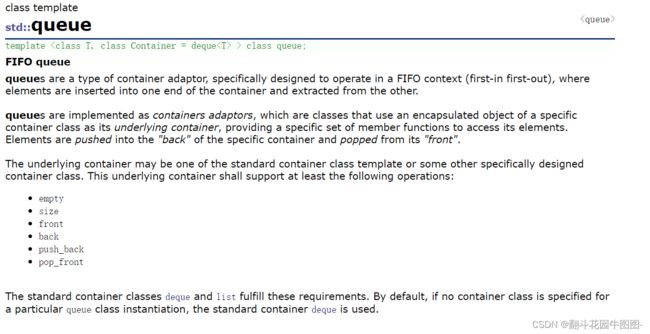C++——stack与queue与容器适配器
1.stack和queue的使用
1.1stack的使用
栈这种数据结构我们应该挺熟了,先入后出,只有一个出口(出口靠栈顶近)嘛
stack的底层容器可以是任何标准的容器类模板或者一些其他特定的容器类,这些容器类应该支持以操作:
- empty:判空操作
- top:获取栈顶元素
- push:往栈压入元素
- pop:从栈顶删除元素
- size:获取栈里有效元素个数
void test()
{
stack s;
s.push(1);
s.push(2);
s.push(3);
s.push(4);
cout << s.size() << endl;
while (!s.empty())
{
cout << s.top() << " ";
s.pop();
}
cout << endl;
} 1.2queue的使用
队列想必也不必我过多介绍,就是排队嘛,先进先出
void test1()
{
queue q;
q.push(1);
q.push(2);
q.push(3);
q.push(4);
q.push(5);
cout << q.size() << endl;
while (!q.empty())
{
cout << q.front() << " ";
q.pop();
}
cout << endl;
} 2.适配器及stack、queue模拟实现
2.1引入
在聊适配器概念之前然我们看看库里面是怎么描述stack和queue的
栈
不想看英文可以看这
1. stack是一种容器适配器 ,专门用在具有后进先出操作的上下文环境中,其删除只能从容器的一端进行元素的插入与提取操作。
2. stack是作为容器适配器被实现的,容器适配器即是对特定类封装作为其底层的容器,并提供一组特定的成员函数来访问其元素,将特定类作为其底层的,元素特定容器的尾部(即栈顶)被压入和弹出。
3. stack的底层容器可以是任何标准的容器类模板或者一些其他特定的容器类,这些容器类应该支持以下
操作:
empty:判空操作
back:获取尾部元素操作
push_back:尾部插入元素操作
pop_back:尾部删除元素操作
4. 标准容器vector、deque、list均符合这些需求,默认情况下,如果没有为stack指定特定的底层容器,默认情况下使用deque。
队列
不想看英文可以看这
1. 队列是一种容器适配器 ,专门用于在FIFO上下文(先进先出)中操作,其中从容器一端插入元素,另一端提取元素。
2. 队列作为容器适配器实现,容器适配器即将特定容器类封装作为其底层容器类,queue提供一组特定的成员函数来访问其元素。元素从队尾入队列,从队头出队列。
3. 底层容器可以是标准容器类模板之一,也可以是其他专门设计的容器类。该底层容器应至少支持以下操作:
empty:检测队列是否为空
size:返回队列中有效元素的个数
front:返回队头元素的引用
back:返回队尾元素的引用
push_back:在队列尾部入队列
pop_front:在队列头部出队列
4. 标准容器类deque和list满足了这些要求。默认情况下,如果没有为queue实例化指定容器类,则使用标准容器deque 。
2.2适配器的概念
库里面提到stack和queue都是一种容器适配器,那么什么是适配器呢?
可以理解一下电源适配器
标准家庭用电电压为220V,我们设备用电其实并不需要这么高,电源适配器是要让家庭用电的电压降低到适合设备使用的电压
站在这个角度理解的话那么,适配器应该是一种设计模式,该种模式是将一个类的接口转换成客户希望的另外一个接口。
2.3 STL标准库中stack和queue的底层结构
虽然stack和queue中也可以存放元素,但在STL中并没有将其划分在容器的行列,而是将其称为容器适配器,这是因为stack和队列只是对其他容器的接口进行了包装,STL中stack和queue默认使用deque:
2.4stack的模拟实现
我这实现的是数组栈
namespace xxx
{
template>
class stack
{
public:
void push(const T& x)
{
_c.push_back(x);
}
void pop()
{
_c.pop_back();
}
T& top()
{
return _c.back();
}
const T& top()const
{
return _c.back();
}
size_t size()const
{
return _c.size();
}
bool empty()const
{
return _c.empty();
}
private:
Con _c;
};
} 测试一下
#include
#include
#include
using namespace std;
#include"stack.h"
void test()
{
xxx::stack> s;
s.push(1);
s.push(2);
s.push(3);
s.push(4);
cout << s.size() << endl;
while (!s.empty())
{
cout << s.top() << " ";
s.pop();
}
cout << endl;
}
int main()
{
test();
return 0;
} 2.5queue的模拟实现
就是调用其他类的接口,没什么难度我就直接上代码了
namespace xxx
{
template>
class queue
{
public:
void push(const T& x)
{
_c.push_back(x);
}
void pop()
{
_c.pop_front();
}
T& back()
{
return _c.back();
}
const T& back()const
{
return _c.back();
}
T& front()
{
return _c.front();
}
const T& front()const
{
return _c.front();
}
size_t size()const
{
return _c.size();
}
bool empty()const
{
return _c.empty();
}
private:
Con _c;
};
} 测一下
void test1()
{
xxx::queue> q;
q.push(1);
q.push(2);
q.push(3);
q.push(4);
q.push(5);
cout << q.size() << endl;
while (!q.empty())
{
cout << q.front() << " ";
q.pop();
}
cout << endl;
} 3.deque
3.1deque引入
我们可以看到上面stack和queue都用deque作为默认的接口,那么deque有什么好呢?
deque(双端队列):是一种双开口的"连续"空间的数据结构,双开口的含义是:可以在头尾两端进行插入和删除操作,且时间复杂度为O(1),与vector比较,头插效率高,不需要搬移元素;与list比较,空间利用率比较高。
库里的介绍
deque(通常发音像“deck”)是双端队列的一个不规则缩写。双端队列是具有动态大小的序列容器,可以在两端(前端或后端)进行扩展或收缩。
特定的库可以以不同的方式实现deques,通常作为某种形式的动态数组。但在任何情况下,它们都允许通过随机访问迭代器直接访问单个元素,并根据需要通过扩展和收缩容器来自动处理存储。因此,它们提供了类似于矢量的功能,但也在序列的开始处,而不仅仅是在序列的结束处,有效地插入和删除元素。但是,与向量不同的是,deque不能保证将其所有元素存储在连续的存储位置:通过将指针偏移到另一个元素来访问deque中的元素会导致未定义的行为。vectors和deque都提供了非常相似的接口,可以用于类似的目的,但在内部都以完全不同的方式工作:虽然vectors使用一个偶尔需要重新分配才能增长的数组,但deque的元素可以分散在不同的存储块中,容器在内部保留必要的信息,以便在恒定时间内直接访问其任何元素,并具有统一的顺序接口(通过迭代器)。因此,deques的内部比向量复杂一点,但这使它们在某些情况下能够更有效地生长,尤其是在非常长的序列中,重新定位变得更加昂贵。对于涉及在除开头或结尾以外的位置频繁插入或删除元素的操作,与列表和前向列表相比,deques的性能更差,迭代器和引用的一致性也更低。
3.2deque的缺陷
与vector比较,deque的优势是:头部插入和删除时,不需要搬移元素,效率特别高,而且在扩容时,也不需要搬移大量的元素,因此其效率是必vector高的。
与list比较,其底层是连续空间,空间利用率比较高,不需要存储额外字段。
但是,deque有一个致命缺陷:不适合遍历,因为在遍历时,deque的迭代器要频繁的去检测其是否移动到某段小空间的边界,导致效率低下,而序列式场景中,可能需要经常遍历,因此在实际中,需要线性结构时,大多数情况下优先考虑vector和list,deque的应用并不多,而目前能看到的一个应用就是,STL用其作为stack和queue的底层数据结构。
3.3为什么选择deque作为stack和queue的底层默认容器
stack是一种后进先出的特殊线性数据结构,因此只要具有push_back()和pop_back()操作的线性结构,都可以作为stack的底层容器,比如vector和list都可以;queue是先进先出的特殊线性数据结构,只要具有push_back和pop_front操作的线性结构,都可以作为queue的底层容器,比如list。但是STL中对stack和 queue默认选择deque作为其底层容器,主要是因为:
1. stack和queue不需要遍历(因此stack和queue没有迭代器),只需要在固定的一端或者两端进行操作。
2. 在stack中元素增长时,deque比vector的效率高(扩容时不需要搬移大量数据);queue中的元素增长时,deque不仅效率高,而且内存使用率高。
结合了deque的优点,而完美的避开了其缺陷。
4.优先级队列 priority_queue
4.1介绍
1. 优先队列是一种容器适配器,根据严格的弱排序标准,它的第一个元素总是它所包含的元素中最大的一个。
2. 此上下文类似于 堆 ,在堆中可以随时插入元素,并且只能检索最大堆元素(优先队列中位于顶部的元素)。
3. 优先队列被实现为容器适配器,容器适配器即将特定容器类封装作为其底层容器类,queue提供一组特定的成员函数来访问其元素。元素从特定容器的“尾部”弹出,其称为优先队列的顶部。
4. 底层容器可以是任何标准容器类模板,也可以是其他特定设计的容器类。容器应该可以通过随机访问迭代器访问,并支持以下操作:
empty():检测容器是否为空
size():返回容器中有效元素个数
front():返回容器中第一个元素的引用
push_back():在容器尾部插入元素
pop_back():删除容器尾部元素
5. 标准容器类vector和deque满足这些需求。默认情况下,如果没有为特定的priority_queue类实例化指定容器类,则使用vector。
6. 需要支持随机访问迭代器,以便始终在内部保持堆结构。容器适配器通过在需要时自动调用算法函数make_heap、push_heap和pop_heap来自动完成此操作。
4.2使用
优先级队列默认使用vector作为其底层存储数据的容器,在vector上又使用了堆算法将vector中元素构造成堆的结构,因此priority_queue就是堆,所有需要用到堆的位置,都可以考虑使用priority_queue。注意:
默认情况下priority_queue是大堆。
void test2()
{
priority_queue pq;
pq.push(1);
pq.push(2);
pq.push(3);
pq.push(4);
pq.push(5);
pq.push(6);
while (!pq.empty())
{
cout << pq.top() << " ";
pq.pop();
}
cout << endl;
} 4.3 实现
template >
class priority_queue
{
public:
void adjust_up(int child)
{
int parent = (child - 1) / 2;
while (child > 0)
{
if (c[child] > c[parent])
{
swap(c[child], c[parent]);
child = parent;
parent = (child - 1) / 2;
}
else
{
break;
}
}
}
void adjust_down(int parent)
{
int child = parent * 2 + 1;
while (child < c.size())
{
if (child + 1 < c.size() && c[child + 1] > c[child])
{
++child;
}
if (c[child] > c[parent])
{
swap(c[child], c[parent]);
parent = child;
child = parent * 2 + 1;
}
else
{
break;
}
}
}
bool empty() const
{
return c.empty();
}
size_t size() const
{
return c.size();
}
const T& top() const
{
return c[0];
}
void push(const T& x)
{
c.push_back(x);
adjust_up(c.size()-1);
}
void pop()
{
swap(c[0], c[c.size() - 1]);
c.pop_back();
adjust_down(0);
}
private:
Container c;
}; 









